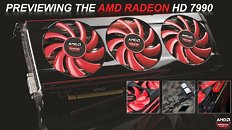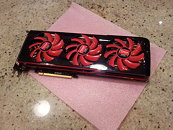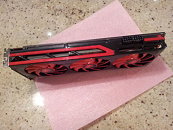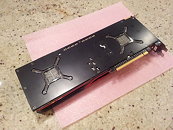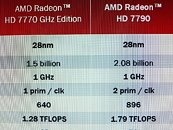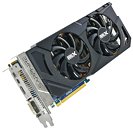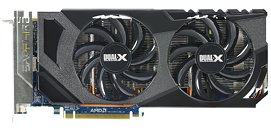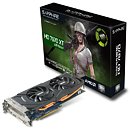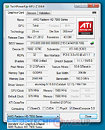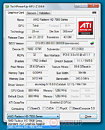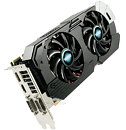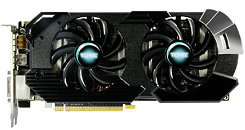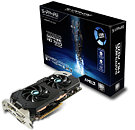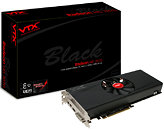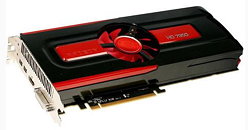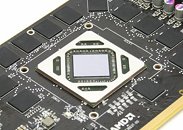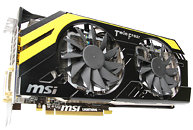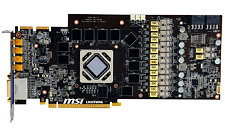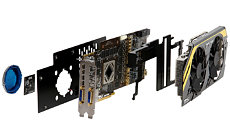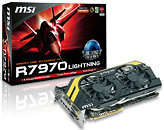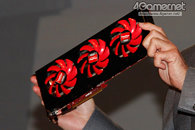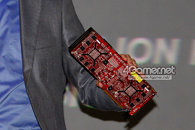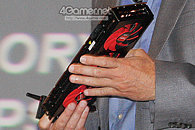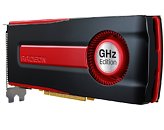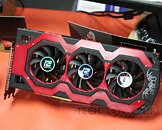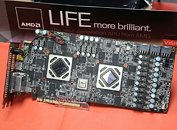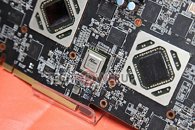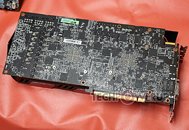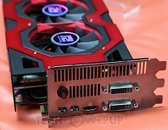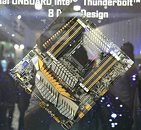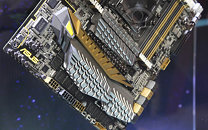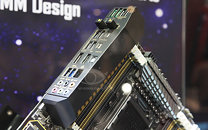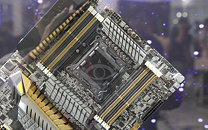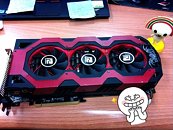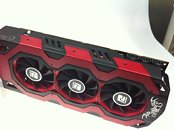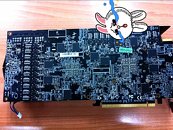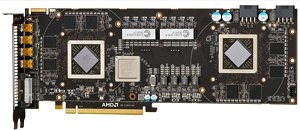Apr 18th, 2025 12:38 EDT
change timezone
Latest GPU Drivers
New Forum Posts
- Lian Li O11 Dynamic XL ROG. (21)
- GPU Pricing and Performance (4)
- RX 9000 series GPU Owners Club (384)
- Is RX 9070 VRAM temperature regular value or hotspot? (359)
- 7900 xtx nitro to aqua bios flash. (1)
- Looking for 4060 MXM-A VBIOS (4)
- SK hynix A-Die (Overclocking thread) only for RYZEN AM5 users (60)
- ThrottleStop Settings i7-10750H (3)
- What's your latest tech purchase? (23569)
- Setting 4k sector size on NVMe SSDs: does performance actually change? (70)
Popular Reviews
- ASUS GeForce RTX 5060 Ti TUF OC 16 GB Review
- NVIDIA GeForce RTX 5060 Ti PCI-Express x8 Scaling
- Palit GeForce RTX 5060 Ti Infinity 3 16 GB Review
- G.SKILL Trident Z5 NEO RGB DDR5-6000 32 GB CL26 Review - AMD EXPO
- ASUS GeForce RTX 5060 Ti Prime OC 16 GB Review
- Zotac GeForce RTX 5060 Ti AMP 16 GB Review
- MSI GeForce RTX 5060 Ti Gaming OC 16 GB Review
- Teevolution Terra Pro Review
- MSI GeForce RTX 5060 Ti Gaming Trio OC 16 GB Review
- ASUS GeForce RTX 5080 TUF OC Review
Controversial News Posts
- NVIDIA GeForce RTX 5060 Ti 16 GB SKU Likely Launching at $499, According to Supply Chain Leak (182)
- NVIDIA Sends MSRP Numbers to Partners: GeForce RTX 5060 Ti 8 GB at $379, RTX 5060 Ti 16 GB at $429 (127)
- Nintendo Confirms That Switch 2 Joy-Cons Will Not Utilize Hall Effect Stick Technology (105)
- Over 200,000 Sold Radeon RX 9070 and RX 9070 XT GPUs? AMD Says No Number was Given (100)
- Nintendo Switch 2 Launches June 5 at $449.99 with New Hardware and Games (99)
- NVIDIA Launches GeForce RTX 5060 Series, Beginning with RTX 5060 Ti This Week (97)
- Sony Increases the PS5 Pricing in EMEA and ANZ by Around 25 Percent (85)
- NVIDIA PhysX and Flow Made Fully Open-Source (77)
News Posts matching #Tahiti
Return to Keyword Browsing
AMD Radeon HD 7990 Launch Date Revealed
Market launch of AMD's Radeon HD 7990 "Malta" dual-GPU graphics card is less than a week away, according to an OCaholic report. Sources told the publication that AMD plans to launch its flagship graphics card on the 24th of April, 2013. According to it, reviews of the card should already be underway. AMD Radeon HD 7990 is the company's flagship graphics card, featuring a pair of 28 nm "Tahiti" GPUs. According to specifications derived from older reports, it packs a total of 4096 stream processors, and 6 GB of GDDR5 memory across two 384-bit wide memory interfaces. What sets this card apart from the HD 7990 "New Zealand" launched last year by AMD's partners is the power-optimizations AMD put into it, leaving the card to draw power from "just" two 8-pin PCIe power connectors, and make do with a dual-slot cooling solution.

AMD Radeon HD 7990 "Malta" Listed on Ebay
A lucky bloke who managed to score an engineering sample of AMD's upcoming Radeon HD 7990 sought to make a quick buck by auctioning it on Ebay. An opening bid of $0.99, and 36 bids (ATP) later, the auction has reached the $1,125 mark. The engineering sample is said to ship with clock speeds of 950 MHz core, and 6.00 GHz memory. The dual-GPU graphics cards ships with two fully-loaded AMD "Tahiti" GPUs, with 2048 stream processors each, and a 384-bit memory interface holding 3 GB of GDDR5 memory, each. If anything the Ebay listing gave us some gorgeous pictures of the beast.

AMD Radeon HD 7790 Physical Specifications, Release Date Confirmed
A presentation slide, allegedly by AMD, leaked by a Japanese distributor confirmed specifications of AMD's upcoming Radeon HD 7790 graphics card. According to the slide, the HD 7790 is indeed based on a brand new silicon, with a transistor count of 2.08 billion. Compare that, to the 1.5 billion TC of "Cape Verde," and 2.80 billion of "Pitcairn." The silicon is built on the 28 nanometer silicon fab process.
The clock speed mentioned in the slide could be core, which is clocked at 1.00 GHz. Next up is the stream processor count, which stands at 896. The HD 7790 is mentioned to feature a primitive rate of 2 prim/clk, suggesting that its component hierarchy is more similar to "Tahiti" than "Cape Verde," which could mean double the tessellation processing power. All said and done, the HD 7790 belts out 1.79 TFLOPs of floating-point performance. The source goes on to mention in its text that the card features a 128-bit wide memory interface, memory clock speed of 6.00 GHz (96 GB/s), a TDP of 85W, and a single 6-pin PCIe power connector. It is expected to launch no later than tomorrow (22/03).
The clock speed mentioned in the slide could be core, which is clocked at 1.00 GHz. Next up is the stream processor count, which stands at 896. The HD 7790 is mentioned to feature a primitive rate of 2 prim/clk, suggesting that its component hierarchy is more similar to "Tahiti" than "Cape Verde," which could mean double the tessellation processing power. All said and done, the HD 7790 belts out 1.79 TFLOPs of floating-point performance. The source goes on to mention in its text that the card features a 128-bit wide memory interface, memory clock speed of 6.00 GHz (96 GB/s), a TDP of 85W, and a single 6-pin PCIe power connector. It is expected to launch no later than tomorrow (22/03).

SAPPHIRE HD 7870 XT with Boost Announced
SAPPHIRE Technology has just announced a new graphics card in its HD 7000 series - the SAPPHIRE HD 7870 XT with Boost. Like the other cards in the HD 7000 series, the new card is based on the highly acclaimed Graphics Core Next architecture from AMD.
The SAPPHIRE HD 7870 XT with Boost delivers a new price : performance point to the series. It is based on AMD's Tahiti architecture with its 256-bit memory interface, and 1280 stream processors and 80 Texture units, unlike the remainder of the HD 7800 series that uses the Pitcairn architecture. Configured with 2 GB of high speed GDDR5 memory running at 1500 MHz (6 GHz effective) the SAPPPHIRE HD 7870 XT has a core clock of 925 MHz which dynamically rises to 975 MHz with PowerTune Boost, AMDs dynamic performance enhancement for games.
The SAPPHIRE HD 7870 XT with Boost delivers a new price : performance point to the series. It is based on AMD's Tahiti architecture with its 256-bit memory interface, and 1280 stream processors and 80 Texture units, unlike the remainder of the HD 7800 series that uses the Pitcairn architecture. Configured with 2 GB of high speed GDDR5 memory running at 1500 MHz (6 GHz effective) the SAPPPHIRE HD 7870 XT has a core clock of 925 MHz which dynamically rises to 975 MHz with PowerTune Boost, AMDs dynamic performance enhancement for games.

Radeon HD 7870 "Tahiti LE" Can Pair with HD 7900 Series in CrossFireX
While testing Club 3D Radeon HD 7870 jokerCard, one of the three Radeon HD 7870 "Tahiti LE" graphics cards you can buy, we discovered that it can pair with Radeon HD 7900 series cards in CrossFireX. Our VGA testing lab, which has battened down the hatches for winter (lack of VGA launches), spent a lot of time toying with Club 3D's card and while brainstorming for the review's conclusion, it came up that HD 7870 Tahiti LE is "bad" because it can't pair with common HD 7870 or HD 7850 "Pitcairn" graphics cards. A bulb supernova just went off over our heads: "...sure Tahiti LE won't pair with Pitcairn, but will it pair with HD 7900 series "Tahiti", which have more stream processors, and more memory?" The answer turned out to be yes!
We successfully managed to pair the Club 3D HD 7870 jokerCard with a Radeon HD 7950 and HD 7970 (reference). We casually put it through 3DMark 11 and Sleeping Dogs, and found the contraptions to scale fairly well. We noticed some micro-stutter in 3DMark 11, but Sleeping Dogs felt smooth. This could be great news for current HD 7900 series owners who can upgrade to CrossFire for a modest $249~269. We even tried our luck at unlocking disabled shaders (stream processors), which didn't work. AMD used the mod-proof fuses method to lock the shaders. Check out our Club 3D HD 7870 jokerCard review.
We successfully managed to pair the Club 3D HD 7870 jokerCard with a Radeon HD 7950 and HD 7970 (reference). We casually put it through 3DMark 11 and Sleeping Dogs, and found the contraptions to scale fairly well. We noticed some micro-stutter in 3DMark 11, but Sleeping Dogs felt smooth. This could be great news for current HD 7900 series owners who can upgrade to CrossFire for a modest $249~269. We even tried our luck at unlocking disabled shaders (stream processors), which didn't work. AMD used the mod-proof fuses method to lock the shaders. Check out our Club 3D HD 7870 jokerCard review.

Probable Radeon HD 8000 Series GPU Specifications Surface
AMD's Radeon HD 8000 "Sea Islands" family of GPUs may arrive some time in Q2-2013, but they won't arrive without a specifications overhaul. While NVIDIA is counting on performance enhancements to come out of higher clock speeds on existing silicon, while maintaining current (or lower) power-draw, with its "Enhanced Kepler" family of GPUs that will include the "GK110" juggernaut, AMD is counting on physically bigger chips with more components. AMD could step up transistor counts of its chips by as much as 20 percent, on existing 28 nm process.
According to a report, the biggest chip from AMD's fold could pack 5.1 billion transistors, amounting to 2560 stream processors, and an updated raster processing engine, with 48 ROPs ("Tahiti" has 32). While the Radeon HD 8970 maxes out the chip's capabilities, the HD 8950 could feature 256 fewer stream processors, at 2304. It could also go light on the clock speeds. AMD's performance-segment chip, codenamed "Sun" could see a similar stream processor increase to 1792, with the Radeon HD 8870 maxing it out, and HD 8850 featuring 1536. It maintains the memory bus width and raster engine layout of its predecessor.
According to a report, the biggest chip from AMD's fold could pack 5.1 billion transistors, amounting to 2560 stream processors, and an updated raster processing engine, with 48 ROPs ("Tahiti" has 32). While the Radeon HD 8970 maxes out the chip's capabilities, the HD 8950 could feature 256 fewer stream processors, at 2304. It could also go light on the clock speeds. AMD's performance-segment chip, codenamed "Sun" could see a similar stream processor increase to 1792, with the Radeon HD 8870 maxing it out, and HD 8850 featuring 1536. It maintains the memory bus width and raster engine layout of its predecessor.

Sapphire Launches Radeon HD 7870 Toxic Graphics Card
Sapphire launched its Radeon HD 7870 Toxic 2 GB graphics card, based on the 28 nm "Tahiti LE" Pitcairn silicon. The card uses a swanky new dual-fan cooler that features a design unlike anything launched by Sapphire so far. It uses a single aluminum fin stack that spans the entire length of the card, to which heat is conveyed by four 8 mm-thick heat pipes that make direct contact with the large die. The card also features a back-plate. It appears to use a high-grade VRM with DirectFETs. The HD 7870 Toxic from Sapphire packs 2 GB of GDDR5 memory across a 256-bit wide memory interface. According to our Sapphire contact, the card is exclusive to the Chinese market.Update 28/11
It turns out this card is a damp squib for two reasons:
It turns out this card is a damp squib for two reasons:
- It's still based on Pitcairn and not the superior Tahiti LE chip
- It's exclusive to the Chinese market

VTX3D Announces Radeon HD 7870 Black Edition (Tahiti LE) Graphics Card
A renowned brand of graphics card maker - VTX3D, unfolds a might weapon to HD7870 series with VTX3D HD7870 Black Edition. The VTX3D HD7870 Black extends the benefits of VTX3D HD7870 series, but taking advantage of progressive GPU design, showing extraordinary performance than before.
The new model consists of ground-breaking feature which runs at a clock of 925MHz, and 6.0 Gbps for memory, even allowing higher frame rates in games by using AMD PowerTune with boost which overdrives core frequency to dynamically overclock up to 975MHz. Also, VTX3D HD7870 Black features 92mm ultra large fan and 3 heat pipes design, which can significantly reduce heats and keep the temperature low.
The new model consists of ground-breaking feature which runs at a clock of 925MHz, and 6.0 Gbps for memory, even allowing higher frame rates in games by using AMD PowerTune with boost which overdrives core frequency to dynamically overclock up to 975MHz. Also, VTX3D HD7870 Black features 92mm ultra large fan and 3 heat pipes design, which can significantly reduce heats and keep the temperature low.

Leading AMD AIB Partners Avoiding "Tahiti LE"?
According to industry sources we spoke with, multiple leading AMD add-in board partners lack plans to launch Radeon HD 7870 "Tahiti LE" graphics cards. The new performance segment SKU is slated for November 27, and already lacks an AMD reference design. The new SKU is being designed as a limited-edition model, targeting limited markets, to help AMD score big on the winter shopping season. Earlier this week, Club 3D defied the November 27 launch date to release the HD 7870 jokerCard, which is believed to stick to the final specifications of "Tahiti LE." Since TUL is the contract manufacturer for Club 3D, one can safely confirm that two AIB brands owned by it, PowerColor and VTX 3D, will announce HD 7870 "Tahiti LE." Incidentally, the three are also among the only AIBs with a Radeon HD 7990 dual-GPU graphics card, apart from HIS.
Based on the 28 nm "Tahiti" silicon, the limited edition Radeon HD 7870 "Tahiti LE" is configured with 1,536 Graphics CoreNext stream processors, a 256-bit wide GDDR5 memory interface holding 2 GB of memory, and clock speeds of 925 MHz core, 975 MHz PowerTune boost, and 6.00 GHz memory (192 GB/s). It is said to be priced competitively with NVIDIA's GeForce GTX 660, while being allegedly 15% faster.
Based on the 28 nm "Tahiti" silicon, the limited edition Radeon HD 7870 "Tahiti LE" is configured with 1,536 Graphics CoreNext stream processors, a 256-bit wide GDDR5 memory interface holding 2 GB of memory, and clock speeds of 925 MHz core, 975 MHz PowerTune boost, and 6.00 GHz memory (192 GB/s). It is said to be priced competitively with NVIDIA's GeForce GTX 660, while being allegedly 15% faster.

AMD "Tahiti LE" to be Launched on November 27
AMD is planning to officially launch its new performance-segment SKU codenamed "Tahiti LE" on November 27. According to a new HT4U report, there won't be an AMD-reference design, and its AIB partners will be free to use their existing HD 7900 series boards to carve out the new SKU. We know from slightly older reports that "Tahiti LE" is being designed to occupy a price point between the Radeon HD 7870 GHz Edition and the Radeon HD 7950, and will be a limited edition, launched in select markets, to cash in on the winter shopping season.

AMD "Tahiti LE" Brand Named Radeon HD 7890
A little earlier this week, it was reported that AMD is working on a new Radeon HD 7800 series graphics card based on the company's 28 nm "Tahiti" silicon. According to a new report, the so-called "Tahiti LE" SKU has been brand named Radeon HD 7890. Although clock speeds, core and memory configurations are still under the wraps, the new SKU, according to the report, is being designed to be 15% faster than GeForce GTX 660 on average, while being similarly priced. AMD is gunning for the crucial X'mas shopping season, when apparently, a few cool people gift high-performance graphics cards.

AMD Readies "Tahiti" Based Radeon HD 7800 Series Product
AMD is reportedly working on a new performance-segment GPU in the Radeon HD 7800 series, based on the 28 nm "Tahiti" silicon (which goes into making HD 7900 series products). The so-called "Tahiti-LE" silicon could help AMD plug a hole between the HD 7870 GHz Edition and HD 7950, getting close to the performance-level of GeForce GTX 660 Ti, at a lower cost. According to a HT4U.net report, AMD is deciding against referring to the new chip as "HD 7930," since the 7900 series is already crowded with five models, and would rather name it something along the lines of "HD 7870 OC."
A similar approach was adopted by NVIDIA in the recent-past, when it created the GeForce GTX 560 Ti 448-cores, using higher-end GF110 silicon to create an SKU traditionally based on GF114. At this time, one can only speculate what the new HD 7870 specifications sheet could look like. Since "Pitcairn" already achieves clock speeds in the 1 GHz range, AMD is left with other features to tinker with. 1536 GCN stream processors seem like a middle ground between the 1280 SP-laden HD 7870 "Pitcairn," and 1792 SP HD 7950. Memory bus width is another component. The new desktop SKU could launch in mid-November. The new SKU could even be a "limited-edition" for the winter shopping season, much like the GTX 560 Ti 448-core.
A similar approach was adopted by NVIDIA in the recent-past, when it created the GeForce GTX 560 Ti 448-cores, using higher-end GF110 silicon to create an SKU traditionally based on GF114. At this time, one can only speculate what the new HD 7870 specifications sheet could look like. Since "Pitcairn" already achieves clock speeds in the 1 GHz range, AMD is left with other features to tinker with. 1536 GCN stream processors seem like a middle ground between the 1280 SP-laden HD 7870 "Pitcairn," and 1792 SP HD 7950. Memory bus width is another component. The new desktop SKU could launch in mid-November. The new SKU could even be a "limited-edition" for the winter shopping season, much like the GTX 560 Ti 448-core.

HIS Coming up with a Radeon HD 7970 X2 Card
PowerColor's HD7990 will soon have some competition as HIS (Hightech Information System) is also going to release a graphics card powered by two AMD Tahiti chips. Dubbed Radeon HD 7970 X2 (apparently HIS doesn't want to use '7990'), this new dual-GPU card features a three-slot, dual-fan cooler, three 8-pin PCIe power connectors, a Lucidlogix PCIe switch (the PowerColor HD7990 uses a PLX bridge), a GPU clock of 1050 MHz, and 6 GB of GDDR5 memory set to 6000 MHz.
HIS' HD 7970 X2 also has dual-DVI and quad mini DisplayPort outputs. Pricing and availability are still unknown.
HIS' HD 7970 X2 also has dual-DVI and quad mini DisplayPort outputs. Pricing and availability are still unknown.

MSI Announces Radeon HD 7970 Lightning Boost Edition Graphics Card
MSI maintained the R7970 Lightning as its flagship AMD Radeon graphics card from March, even after AMD launched the Radeon HD 7970 GHz Edition in June. The company finally decided to combine its R7970 Lightning board with the new "Tahiti XT2" Radeon HD 7970 GHz Edition ASIC, creating the R7970 Lightning Boost Edition (BE). While the original R7970 Lightning shipped with 1070 MHz core and 5.60 GHz memory, the new R7970 Lightning BE ships with 1070 MHz core, 1150 MHz PowerTune Boost, and 6.00 GHz memory (288 GB/s). It packs 3 GB of GDDR5 memory across a 384-bit wide memory interface.
Most other features remain the same. The R7970 Lightning BE packs an enthusiast-grade 17-phase VRM, dual-BIOS, voltage-conditioning GPU Reactor module, and TwinFrozr IV cooling solution. Quite shockingly, MSI didn't take the opportunity to address the lack of dual-link DVI connectors in the original R7970 Lightning, the Lightning BE continues to have two single-link DVI, and four mini-DisplayPort connectors. The new R7970 Lightning BE could displace the original from its US $499.99 price-point.
Most other features remain the same. The R7970 Lightning BE packs an enthusiast-grade 17-phase VRM, dual-BIOS, voltage-conditioning GPU Reactor module, and TwinFrozr IV cooling solution. Quite shockingly, MSI didn't take the opportunity to address the lack of dual-link DVI connectors in the original R7970 Lightning, the Lightning BE continues to have two single-link DVI, and four mini-DisplayPort connectors. The new R7970 Lightning BE could displace the original from its US $499.99 price-point.

AMD Supercomputing Leadership Continues with Broader Developer Ecosystem, Latest Tech
AMD today announced its continued leadership in high performance computing (HPC) with 24 of the top 100 supercomputers in the 39th TOP500 list, announced today, while making significant strides in maturing its HPC ecosystem through the addition of several key components that enable end users to continue to benefit from best-in-class price/performance for today's demanding applications.
AMD has continued to work closely with its technology partners to significantly mature its HPC ecosystem, resulting in several new developments including LS-DYNA simulation software optimized for the AMD Opteron 6200 Series processors from Livermore Software Technology Corporation (LSTC), the addition of programming options for AMD graphics processor unit (GPU) technology from CAPS, and the announcement by Mellanox Technologies of its Connect-IB products that will deliver FDR 56 Gb/s InfiniBand speeds to AMD's solution portfolios.
AMD has continued to work closely with its technology partners to significantly mature its HPC ecosystem, resulting in several new developments including LS-DYNA simulation software optimized for the AMD Opteron 6200 Series processors from Livermore Software Technology Corporation (LSTC), the addition of programming options for AMD graphics processor unit (GPU) technology from CAPS, and the announcement by Mellanox Technologies of its Connect-IB products that will deliver FDR 56 Gb/s InfiniBand speeds to AMD's solution portfolios.

AMD FirePro W9000 Dual-GPU Graphics Card Pictured, Design Precursor of HD 7990?
At the AMD Fusion Developer Summit (AFDS) 2012, the host unveiled its next flagship professional graphics card, the FirePro W9000. What makes the card particularly interesting is that it is dual-GPU, packing two Tahiti-derived GPUs, the same chips that go into making Radeon HD 7900 series. The FirePro W9000, is what many believe to be a professional variant of the Radeon HD 7990 "New Zealand" dual-GPU graphics card, which is facing delays for reasons unknown (actually, here's a possible reason).
The W9000 packs a total of 6 GB of GDDR5 memory, up to 264.8 million pixels/s; 4 TFLOPs single-precision and 1 TFLOPs double-precision floating-point performance. The card design does away with lateral-flow cooler, and uses a triple-fan heatsink assembly that packs three 90 mm low-speed (low-noise) fans. A surprise here, is that the card draws power from [just] two 8-pin PCIe power connectors (it's probably using two low-voltage Tahiti chips). It's an established fact that FirePro products are merely variations of Radeon products with possibly higher build quality, and an expanded software feature-set.
The W9000 packs a total of 6 GB of GDDR5 memory, up to 264.8 million pixels/s; 4 TFLOPs single-precision and 1 TFLOPs double-precision floating-point performance. The card design does away with lateral-flow cooler, and uses a triple-fan heatsink assembly that packs three 90 mm low-speed (low-noise) fans. A surprise here, is that the card draws power from [just] two 8-pin PCIe power connectors (it's probably using two low-voltage Tahiti chips). It's an established fact that FirePro products are merely variations of Radeon products with possibly higher build quality, and an expanded software feature-set.

AMD Radeon HD 7970 GHz Edition "Tahiti XT2" Detailed
We've known since May, the existence of a new high-end single-GPU graphics card SKU in the works, at AMD. Called the Radeon HD 7970 GHz Edition, the SKU is being designed to regain AMD's competitiveness against NVIDIA's GeForce GTX 680. We're hearing a few additional details about the SKU. To begin with, AMD has worked with TSMC to refine the chip design. The Tahiti XT2 will be able to facilitate significantly higher clock speeds, at significantly lower voltages, than the current breed of Tahiti XT chips.
Tahiti XT2, or Radeon HD 7970 GHz Edition, will ship with a core clock speed of 1100 MHz, 175 MHz faster than the HD 7970. The GPU core voltage of Tahiti XT2 will be lower, at 1.020V, compared to 1.175V of the Tahiti XT. It's unlikely that AMD will tinker with memory clock speed, since Tahiti already has a 384-bit wide GDDR5 memory interface, which gives it 264 GB/s memory bandwidth at 1375 MHz (5.50 GHz effective). According to the source, the new SKU enters mass-production next week. So best case, it should reach markets by late-June or early-July.
Tahiti XT2, or Radeon HD 7970 GHz Edition, will ship with a core clock speed of 1100 MHz, 175 MHz faster than the HD 7970. The GPU core voltage of Tahiti XT2 will be lower, at 1.020V, compared to 1.175V of the Tahiti XT. It's unlikely that AMD will tinker with memory clock speed, since Tahiti already has a 384-bit wide GDDR5 memory interface, which gives it 264 GB/s memory bandwidth at 1375 MHz (5.50 GHz effective). According to the source, the new SKU enters mass-production next week. So best case, it should reach markets by late-June or early-July.

AMD Readies Trio of New Radeon HD 7900 Series SKUs
Apart from a few Radeon HD 7970 "X2" dual-GPU graphics cards, and a few non-reference design HD 7970, we didn't hear much about new Radeon SKUs, at Computex. AMD or its partners never even talked about the Radeon HD 7990. It appears now, that the company is working on three new SKUs that will likely replace existing ones, in a bid to replenish the competitiveness of its "Southern Islands" GPU family. The three new SKUs include the Radeon HD 7990, of which we've been hearing for a greater part of this year; the Radeon HD 7970 GHz Edition, which we knew was taking shape for some time now; and the new Radeon HD 7930.
Launch of the Radeon HD 7990 has been facing quite a few delays. We can't imagine technical hurdles with regard to board design, but the performance yield, and performance-per-Watt figures the SKU will have to produce, to ever make it to the market. The HD 7990 has the tough task of performing within an acceptable range of the GeForce GTX 690, on both these fronts.
Launch of the Radeon HD 7990 has been facing quite a few delays. We can't imagine technical hurdles with regard to board design, but the performance yield, and performance-per-Watt figures the SKU will have to produce, to ever make it to the market. The HD 7990 has the tough task of performing within an acceptable range of the GeForce GTX 690, on both these fronts.

Key Details About PowerColor HD 7970 X2 Devil 13 Surface
We've been hearing about PowerColor's Radeon HD 7970 X2 Devil 13 dual-GPU graphics card since late-May. A little earlier at Computex, we got to see the card taken apart. We spoke at lengths to reliable sources about the card. To begin with, PowerColor plans to clock the two "Tahiti" GPUs in excess of 1050 MHz (above even the single-GPU HD 7970, and its 925 MHz core clock). Next up, PowerColor will manufacture the card in limited quantities, and will release it to market towards the end of July. Lastly, the PowerColor HD 7970 X2 Devil 13 will be priced around €1,200 (including VAT), its US pricing will be around $1,200. You've heard it first on TechPowerUp!

PowerColor HD 7970 X2 Devil 13 Taken Apart
Here are the first pictures of PowerColor's ambitious Radeon HD 7970 X2 Devil 13 dual-GPU graphics card taken apart. The pictures reveal a PCB that's both longer and taller than that of the HD 7970, to create room for two 28 nm "Tahiti" GPUs, a total of 24 GDDR5 memory chips (12 on each side), a PLX PEX8747 PCIe 3.0 bridge chip, and a VRM that consists of 5+2+1 phases per GPU system. The card draws power from three 8-pin PCIe power connectors. The VRM consists of solid-state chokes and Renesas Driver-MOSFETs. Display outputs include two each of DVI and mini-DP, and an HDMI. Each GPU system has a pair of BIOS'es (performance and failsafe).

ASUS ROG ZEUS Fuses LGA2011 Motherboard with Dual-GPU Graphics
ASUS displayed a nerdtastic motherboard design concept, at Computex. Called the Republic of Gamers ZEUS, ASUS' creation is a socket LGA2011 motherboard with a dual-GPU graphics hardware soldered onto the board, in the place otherwise assigned for expansion slots. The top half of the ZEUS resembles that of a conventional LGA2011 motherboard, with the processor being powered by a 10-phase Digi+ VRM, and eight DDR3 DIMM slots. ASUS somehow made the platform support up to 128 GB of unregistered DIMM DDR3 memory (double the 64 GB limit of the Sandy Bridge-E HEDT platform).
The second half of the motherboard has the X79 PCH, and two PCI-Express 3.0 GPUs in dual-GPU configuration. ASUS hasn't revealed which GPUs these are, but sources predict it's a pair of AMD Radeon HD 7970 (Tahiti XT) or HD 7870 (Pitcairn XT). Each GPU system has its own set of memory, and a set of 8-pin + 6-pin PCIe power connectors. The display outputs of this dual-GPU setup are given out on the rear panel, as two mini-DP + Thunderbolt ports, and one each of HDMI and standard DP. The ZEUS even has as many as 8 SATA 6 Gb/s ports, four SATA 3 Gb/s ports, and 12 USB 3.0 ports, besides two Thunderbolt 10 Gb/s ports. For now, ASUS' monstrosity is a design concept, and the company is undecided about launching it to the market. If nothing, the ZEUS serves as a testament of ASUS' mammoth engineering potential.
The second half of the motherboard has the X79 PCH, and two PCI-Express 3.0 GPUs in dual-GPU configuration. ASUS hasn't revealed which GPUs these are, but sources predict it's a pair of AMD Radeon HD 7970 (Tahiti XT) or HD 7870 (Pitcairn XT). Each GPU system has its own set of memory, and a set of 8-pin + 6-pin PCIe power connectors. The display outputs of this dual-GPU setup are given out on the rear panel, as two mini-DP + Thunderbolt ports, and one each of HDMI and standard DP. The ZEUS even has as many as 8 SATA 6 Gb/s ports, four SATA 3 Gb/s ports, and 12 USB 3.0 ports, besides two Thunderbolt 10 Gb/s ports. For now, ASUS' monstrosity is a design concept, and the company is undecided about launching it to the market. If nothing, the ZEUS serves as a testament of ASUS' mammoth engineering potential.

PowerColor Radeon HD 7970 X2 Devil13 Graphics Card Detailed
Last week, we were teased with the first picture of PowerColor's Vortex III cooling solution. A little later that week, we also got reports that AMD's add-in board (AIB) partners are working on off-spec dual-GPU graphics accelerators, calling them "Radeon HD 7970 X2", even as AMD's own HD 7990 is on course. It turns out that the card the Vortex III is designed to cool is PowerColor's newest high-end creation, the Radeon HD 7970 X2 Devil13.
Decked in red and black, the card is a custom-design dual-GPU graphics card from PowerColor, which incorporates two 28 nm Tahiti GPUs in CrossFire configuration. The GPUs have all their components enabled, and clocked on par with single-GPU Radeon HD 7970. The two GPU systems cumulatively hold 6 GB of GDDR5 memory (3 GB per GPU, over 384-bit wide interface). The card draws power from three 8-pin PCI-Express power connectors, and has a rated TDP of 525W. The card will be exhibited at Computex, where it will be further detailed.
Decked in red and black, the card is a custom-design dual-GPU graphics card from PowerColor, which incorporates two 28 nm Tahiti GPUs in CrossFire configuration. The GPUs have all their components enabled, and clocked on par with single-GPU Radeon HD 7970. The two GPU systems cumulatively hold 6 GB of GDDR5 memory (3 GB per GPU, over 384-bit wide interface). The card draws power from three 8-pin PCI-Express power connectors, and has a rated TDP of 525W. The card will be exhibited at Computex, where it will be further detailed.

AMD AIB Partners Said to be Working on "HD 7970 X2"
Although AMD has plans to unveil its dual-GPU Radeon HD 7990 some time during Computex 2012, next month, it is reported that its add-in board (AIB) partners will be rolling out custom-design dual-GPU graphics cards labelled "Radeon HD 7970 X2." These cards most likely feature a pair of 28 nm "Tahiti" GPUs with high GPU clock speeds (perhaps above those of the HD 7990, perhaps even over 1 GHz). The new cards could then target the performance levels of NVIDIA's GeForce GTX 690 at competitive prices. It could also be AMD's strategy to give the onus to AIB partners to come up with "off-spec" dual-GPU cards to compete with GTX 690 in terms of performance, while maintaining an "on-spec" Radeon HD 7990 that seeks a higher price-performance ratio than that of the GTX 690.

AMD Readies Radeon HD 7970 GHz Edition
AMD's Radeon HD 7970 could not hold on to the single-GPU performance crown for too long. It lost it to NVIDIA GeForce GTX 680, and the upcoming GeForce GTX 670 threatens to damage its competitiveness even further. Reports suggest that AMD is working on a new Tahiti-based graphics card SKU, the Radeon HD 7970 GHz Edition. AMD unveiled the "GHz Edition" moniker to denote SKUs that come with engine clock speed ≥1 GHz. The new HD 7970 GHz Edition will come with reference core clock speed of 1050 MHz.
AMD needn't tinker with memory clock speed, as it already has a 384-bit wide GDDR5 memory interface compared to the GeForce GTX 680 and its 256-bit memory bus width. Sources told Atomic PC that improved yields and manufacturing processes have benefitted Tahiti just as well as GK104, and ES Tahiti chips from the latest batches "easily" hit 1250 MHz core. These batches could make custom-design graphics cards with extremely high core clock speeds possible.
AMD needn't tinker with memory clock speed, as it already has a 384-bit wide GDDR5 memory interface compared to the GeForce GTX 680 and its 256-bit memory bus width. Sources told Atomic PC that improved yields and manufacturing processes have benefitted Tahiti just as well as GK104, and ES Tahiti chips from the latest batches "easily" hit 1250 MHz core. These batches could make custom-design graphics cards with extremely high core clock speeds possible.

AMD Chooses Computex 2012 as Radeon HD 7990 Launchpad
Even as NVIDIA is on the verge of unveiling its GeForce GTX 690 dual-GPU graphics card, at GeForce LAN Shanghai, AMD is in no hurry. Its competitive graphics card to the GTX 690, the Radeon HD 7990 "New Zealand", will be kept under the wraps till Computex 2012 (early June), DonanimHaber learned. Radeon HD 7990 will pack two completely unlocked 28 nm "Tahiti" GPUs, a total of 4,096 Graphics CoreNext stream processors, 6 GB of GDDR5 memory, and the ability to drive 6-monitor Eyefinity, out of the box.
Apr 18th, 2025 12:38 EDT
change timezone
Latest GPU Drivers
New Forum Posts
- Lian Li O11 Dynamic XL ROG. (21)
- GPU Pricing and Performance (4)
- RX 9000 series GPU Owners Club (384)
- Is RX 9070 VRAM temperature regular value or hotspot? (359)
- 7900 xtx nitro to aqua bios flash. (1)
- Looking for 4060 MXM-A VBIOS (4)
- SK hynix A-Die (Overclocking thread) only for RYZEN AM5 users (60)
- ThrottleStop Settings i7-10750H (3)
- What's your latest tech purchase? (23569)
- Setting 4k sector size on NVMe SSDs: does performance actually change? (70)
Popular Reviews
- ASUS GeForce RTX 5060 Ti TUF OC 16 GB Review
- NVIDIA GeForce RTX 5060 Ti PCI-Express x8 Scaling
- Palit GeForce RTX 5060 Ti Infinity 3 16 GB Review
- G.SKILL Trident Z5 NEO RGB DDR5-6000 32 GB CL26 Review - AMD EXPO
- ASUS GeForce RTX 5060 Ti Prime OC 16 GB Review
- Zotac GeForce RTX 5060 Ti AMP 16 GB Review
- MSI GeForce RTX 5060 Ti Gaming OC 16 GB Review
- Teevolution Terra Pro Review
- MSI GeForce RTX 5060 Ti Gaming Trio OC 16 GB Review
- ASUS GeForce RTX 5080 TUF OC Review
Controversial News Posts
- NVIDIA GeForce RTX 5060 Ti 16 GB SKU Likely Launching at $499, According to Supply Chain Leak (182)
- NVIDIA Sends MSRP Numbers to Partners: GeForce RTX 5060 Ti 8 GB at $379, RTX 5060 Ti 16 GB at $429 (127)
- Nintendo Confirms That Switch 2 Joy-Cons Will Not Utilize Hall Effect Stick Technology (105)
- Over 200,000 Sold Radeon RX 9070 and RX 9070 XT GPUs? AMD Says No Number was Given (100)
- Nintendo Switch 2 Launches June 5 at $449.99 with New Hardware and Games (99)
- NVIDIA Launches GeForce RTX 5060 Series, Beginning with RTX 5060 Ti This Week (97)
- Sony Increases the PS5 Pricing in EMEA and ANZ by Around 25 Percent (85)
- NVIDIA PhysX and Flow Made Fully Open-Source (77)
